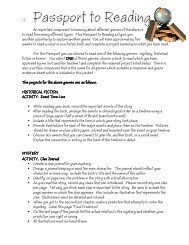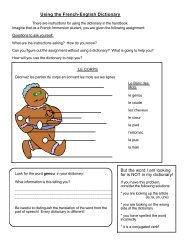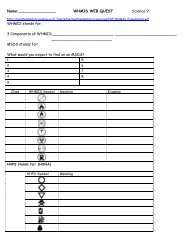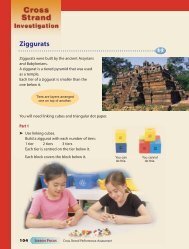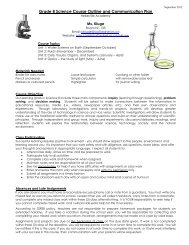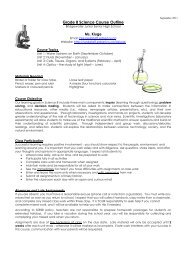1 Unit 4 â Conservation of Mass and Stoichiometry
1 Unit 4 â Conservation of Mass and Stoichiometry
1 Unit 4 â Conservation of Mass and Stoichiometry
You also want an ePaper? Increase the reach of your titles
YUMPU automatically turns print PDFs into web optimized ePapers that Google loves.
8-3 Activity Series <strong>of</strong> the Elements<br />
A. Activity Series<br />
1. A list <strong>of</strong> elements organized according to the ease with which the elements undergo certain chemical<br />
rxns<br />
2. Each element in the list displaces from a compound any <strong>of</strong> the elements below it. The larger the<br />
interval between elements in a series, the more vigorous the replacement rxn.<br />
3. Metals may replace other metals<br />
4. Halogens may replace other halogens<br />
B. Using the Activity Series (Table 8-3 in your book)<br />
1. All metals above hydrogen displace hydrogen from hydrochloric acid or dilute sulfuric acid<br />
2. Metals above magnesium vigorously displace hydrogen from water. Magnesium displaces hydrogen<br />
from steam.<br />
3. Metals above silver combine directly with oxygen; those near the top do so rapidly<br />
4. Metals below mercury form oxides only indirectly.<br />
5. Oxides <strong>of</strong> metals below mercury decompose with mild heating.<br />
6. Oxides <strong>of</strong> metals below chromium easily undergo reduction to metals by heating with hydrogen<br />
7. Oxides <strong>of</strong> metals above iron resist reduction by heating with hydrogen<br />
8. Elements near the top <strong>of</strong> the series are never found free in nature<br />
9. Elements near the bottom <strong>of</strong> the series are <strong>of</strong>ten found free in nature.<br />
Table 8-3 Activity Series <strong>of</strong> the Elements<br />
Activity <strong>of</strong> metals<br />
Activity <strong>of</strong> halogens<br />
Li F 2<br />
Rb Cl 2<br />
K React with cold H2O <strong>and</strong> acids, replacing Br 2<br />
Ba hydrogen. React with oxygen, forming oxides. I 2<br />
Sr<br />
Ca<br />
Na<br />
Mg<br />
Al<br />
Mn<br />
Zn<br />
Cr<br />
Fe<br />
Cd<br />
React with steam (but not cold water) <strong>and</strong><br />
acids, replacing hydrogen. React with oxygen,<br />
forming oxides.<br />
Co<br />
Ni<br />
Sn<br />
Pb<br />
H 2<br />
Sb<br />
Bi<br />
Cu<br />
Hg<br />
Ag<br />
Pt<br />
Au<br />
Do not react with water. React with acids,<br />
replacing hydrogen. React with oxygen,<br />
forming oxides.<br />
React with oxygen, forming oxides.<br />
Fairly unreactive, forming oxides only<br />
indirectly.<br />
6



